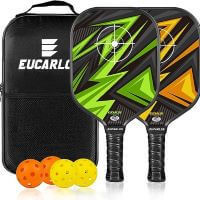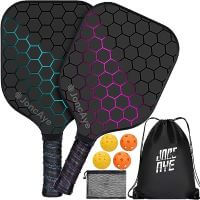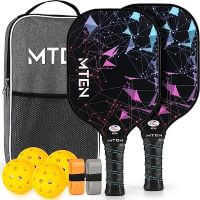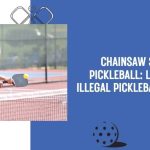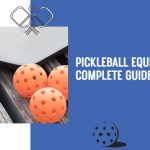The most important aspect of pickleball is the serve. That can be either legal or illegal depending on how it’s done.
Legal serves must meet certain criteria. Such as height and speed, while illegal serves are those that don’t follow the rules.
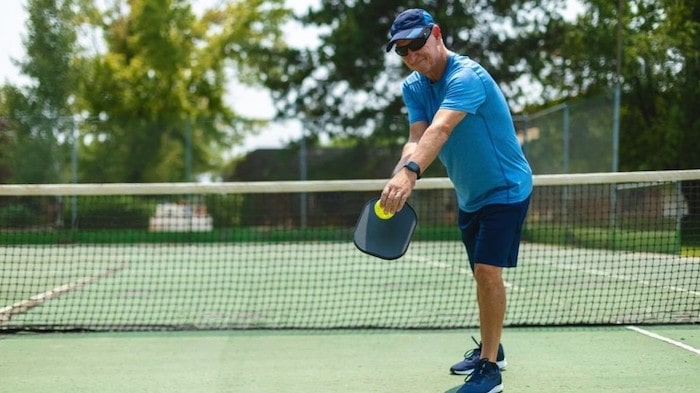
In this blog post, we’ll take an in-depth look at both legal and illegal pickleball serves. So you can better understand them and make sure your serve follows all the necessary rules for successful play.
We’ll also discuss the penalty for an Illegal serve in pickleball!
You Might Also Like:
What Is a Legal and Illegal Serve in Pickleball?
A legal serve is one that follows all the necessary guidelines. Set forth by pickleball’s governing body – USA Pickleball Association (USAPA).
These guidelines include: where you can stand when serving (on one side of the court only), how you position your feet before serving (both feet stay behind the baseline), and how you hold your paddle when serving (one hand only).
USAPA regulations consider these serves “legal” when executed properly.
On the other hand, an illegal pickleball serves occurs when any of these parameters are not met.
Any violation results in a loss of points for the player who committed the violation. Or their team depending upon the particular rule set being followed at the time during play like IFP standard Rule Set, etc…
Types of Legal Serves in Pickleball
Two main types of serves used in pickleball are underhand serves and forehand serve. Each type requires different techniques, but each can result in successful points if executed correctly!
Underhand Serve:
The underhand serve is one of the legal serves in pickleball. It’s often considered easier and more beginner-friendly than other types of serves. Due to its slower speed and lower trajectory over the net.
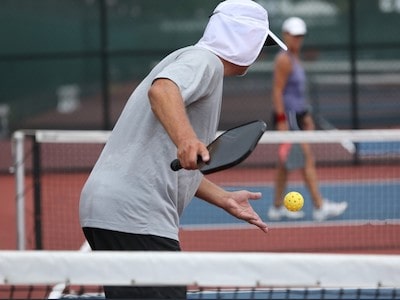
To perform an underhand serve, stand behind the baseline with your feet parallel to each other or slightly staggered. Hold your paddle at waist level, facing downwards. Then toss or drop it no higher than 6 inches. And hit it forward before it bounces on your side of the court.
This type of serve should land diagonally from where you hit it. In order for you not to fault prior to returning over the net into the opposite service box.
Forehand Serve:
The most common serve is the forehand serve. This involves standing on the right side of your court, facing toward your opponent’s court.
The player begins by throwing the ball up and then hitting it with their paddle in a forward motion, across their own service line into their opponent’s court diagonally.
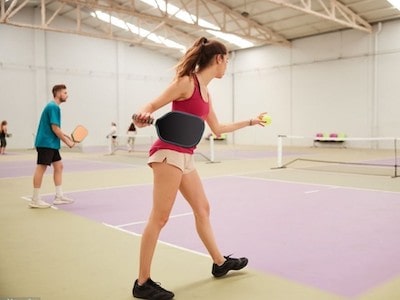
It is important for players to remember that they must keep at least one foot planted behind the baseline when serving. And that both feet must remain inside their service area prior to hitting the ball.
Types of Illegal Serves in Pickleball
Pickleball is a fun and exciting sport that is growing rapidly in popularity. Unfortunately, many players are unaware of the rules regarding illegal serves. And find themselves in trouble with their opponents or referees.
We have jotted down the three illegal serves in pickleball, which one should keep in mind while playing the game.
Overhead Serve:
An illegal overhead serve occurs when the server strikes the ball, with an upward motion. To hit it over the net without bouncing it first on his/her side of the court.
This type of serve is not allowed because it gives an unfair advantage to the server. By allowing them to hit a shot directly at their opponent’s head. And making it difficult for them to return.
A player can be warned or even penalized for breaking this rule if they do this.
Double Hit Serve:
The most common illegal serve in pickleball is known as a double hit serve. This occurs when the player hits the ball more than once with their paddle before it crosses over to their opponent’s court.
A double-hit serve can be intentional or accidental, but either way, it will result in an immediate loss of points for the serving team.
If this action continues to occur throughout the match, coach may apply further penalties. Such as disqualification from the game or tournament altogether.
Carry or Throw Serve:
The carry or throw serve, also known as the push or lob serve, is illegal and should not be attempted in any game of pickleball. This type of serve involves taking the ball, and either throwing it up into the air to hit over the net or carrying it with a paddle before hitting it over.
An umpire can award a point to the opponent’s team if they catch either of these serves to be illegal.
A good way to remember this rule is that “the wrist must do most work” when serving, as opposed to using one’s shoulder for power.
Illegal serves can often lead to arguments on the court between players due to their obvious advantage, so make sure you avoid any attempts to carry or throw serves during your games!
Also, check out our blogs on pickleball singles vs doubles, and how to keep score in pickleball.
Penalty for an Illegal Serve in Pickleball
An illegal serve in pickleball is considered a fault and results in a point for the other team. Depending on the severity of the fault, it may also result in a warning from the referee or umpire.
In tournament play, repeated violations can result in expulsion from the game or even disqualification from the tournament. It is important to remember that all players should be aware of their surroundings, and abide by all rules when playing pickleball to avoid any penalties.
Point to Opponent Team:
The most common penalty for an illegal serve in pickleball is a point to the opposing team. The opponent’s team will always receive a point for any violation made.
The rules hold players accountable for their actions and prevent them from taking advantage of loopholes. Additionally, it gives players an incentive to practice proper serving techniques, as mistakes can be costly in terms of points.
Loss Of Service:
In some cases, an illegal serve may result in a loss of service for the offending player or team. This means that they will have to switch sides on the court, and forfeit their next turn at serving until after their opponent has served twice (or once if playing doubles).
This gives them time to reset and refocus before returning to action. This can be beneficial for those who are struggling with consistency issues. When serving correctly within regulation parameters specified by a governing body, the respective sport involved case pickleball, USAPA.
FAQs
A serve in pickleball is considered illegal if it does not follow certain rules. First, the ball must be served diagonally from one side of the court to the other. If a player serves from any other direction, it is considered an illegal serve. Furthermore, a player must let go of their paddle before making contact with the ball. If they do not, then this also constitutes an illegal serve. Additionally, a player’s foot cannot cross over to the opposite side of their baseline while serving, as this too would be deemed an illegal serve.
The first rule is that the server must serve the ball diagonally, over the net, to the other side of the court. The second rule is that when serving the ball, it must be hit below your waist and with an underhand swing motion. The third rule states that you must wait until your opponent has had a chance to return your service before you can go for another shot or rally point.
Due to the Covid-19 pandemic, new serving rules have been implemented for pickleball. To start a point, the server must stand at least 6 feet away from their opponent and may not take more than 10 seconds to serve. When switching sides of the court after each point, players should move in opposite directions and maintain a safe distance from one another. Additionally, all shared items such as paddles and balls should be sanitized between each game or match.
Players are not allowed to throw the ball up into the air, and catch it before serving, nor are they allowed to serve with their feet. It is also illegal for a player to take more than one step when making a serve. The ball must be hit with one continuous motion and must not touch any part of the body or clothing of the server before striking the racket. Additionally, players cannot bounce the ball before serving; it must either be tossed or released from an open hand.
Blocking a serve is a technique in which the player attempts to stop an oncoming attack by jumping and making contact with the ball before it crosses over the net. It is commonly used when the opponent has an aggressive serve that would be difficult to return, or when there are no other options available for returning the serve. Blocking can be a great way to turn defense into offense and gain momentum during a match.
No, the return of serve does not have to clear the kitchen in pickleball. The rules allow players to hit a ball anywhere on their side of the court as long as it doesn’t land within the kitchen area. The player may also choose to hit into or near the kitchen area and allow their opponent to play out of it if they wish. Other options include hitting over or around the net post, hitting down either sideline, or playing a lob shot that lands beyond and outside the kitchen.
Well, It’s a Wrap!
In conclusion, understanding what constitutes legal and illegal pickleball serves is important knowledge for all players.
Whether you’re just starting out or have been playing for years!
Having a good grasp of these guidelines will help you avoid any unnecessary penalties while keeping your game running smoothly.
Remember – following these rules will not only make sure you stay safe, but also keep your opponents happy by ensuring fair play throughout your matches!

I am the founder of BallSportsPro, a popular pickleball resource for players of all levels. I am a former professional tennis player, started playing pickleball in 2009 and quickly fell in love with the game. I launched BallSportsPro in 2018 to share my passion for the sport and to provide pickleball players with the latest news, tips, and gear reviews. Today, BallSportsPro is one of the most popular pickleball resources on the web, reaching hundreds of thousands of players each month. In addition to running the website, I also a regular contributor to Pickleball Magazine and a member of the USAPA Pickleball Ambassadors program.

